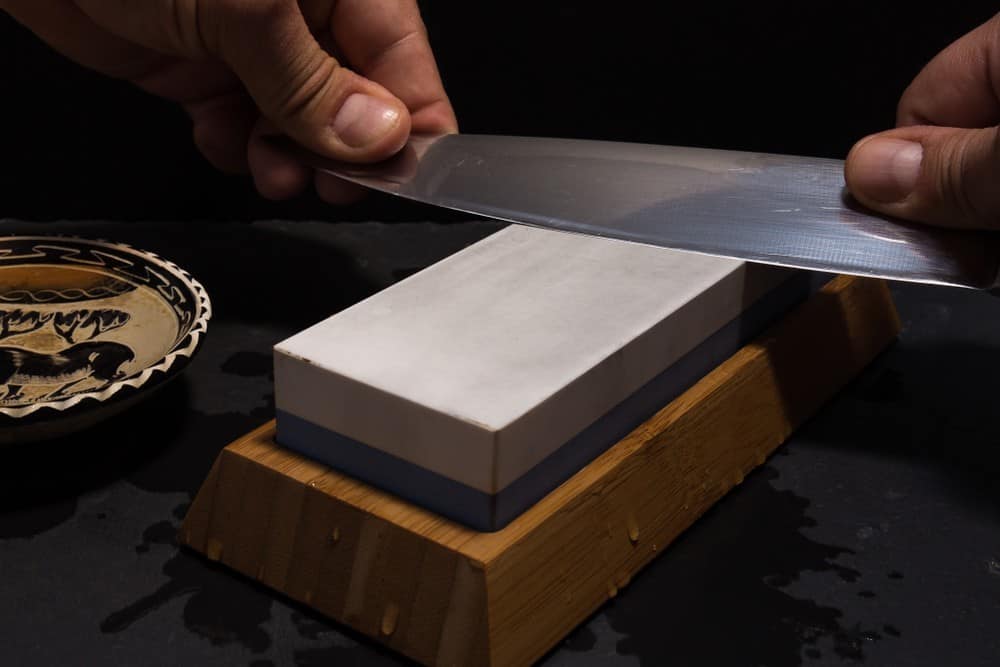
f
TL;DR
If you’re in a rush, here are my picks for the best Japanese whetstones:
- Best beginner / entry-level: King 1000 / 6000 combo whetstone
- Best mid-level: Shapton Pro 1000
- Best premium: Gesshin Stones / Naniwa Pro line
This guide will help you choose the best Japanese whetstone for sharpening your kitchen knife.
Maintaining a sharp knife is an important part of becoming a better chef. It will make your prep work faster, and more enjoyable. With proper knife skills, a sharp knife is also much safer than a dull one.
All blades will eventually dull. If you are just cooking at home, you probably only need to sharpen your knife once or twice per month at most. Professional chefs will need to sharpen their knives daily / weekly.
The best — and only recommended — way to sharpen and maintain your Japanese kitchen knife is with a whetstone.
The Best Japanese Whetstone
Before we look at some whetstone recommendations, let’s first learn what a whetstone is, and the different types available.
Want to skip ahead?
Choose a section: What is a whetstone? / Types of Whetstones / Choosing a whetstone / Best whetstone recommendations
What is a whetstone?
A “whetstone” — sometimes called a water stone (usually for Japanese versions) — is simply another word for “sharpening stone”. The word “whet” actually means “to sharpen (a knife or other type of tool)”. It has nothing to do with water, or being wet. This was very confusing to me at first.
The history of whetstone usage in Japan is extensive. Whetstones were mined and processed for centuries, and were essential for military purposes (i.e. for sword sharpening). Thanks to the historical importance of whetstones, the Japanese were able to develop excellent blade grinding and sharpening techniques over time. This tradition continues today as Japan constantly produces some of the best hand made kitchen knives in the world.
There are various types and categories of whetstones available. It can all be very confusing at first. I will try my best to explain as I understand it.
Types of Whetstones
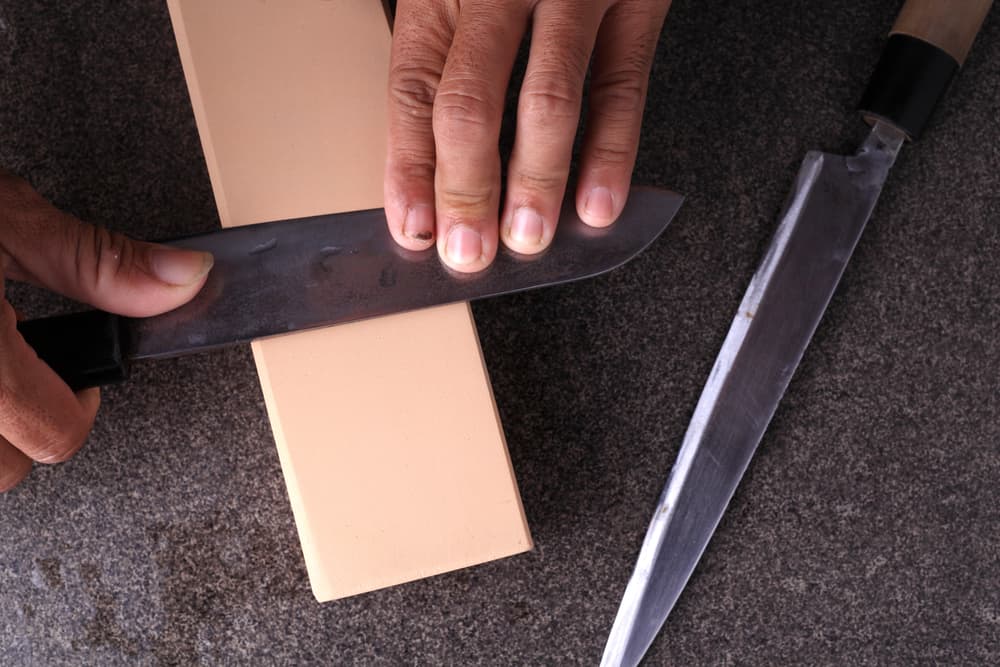
Whetstones can be categorized in many ways. Let’s take a look at a few of the main categories you will come across: natural whetstones, synthetic whetstones, grit size, and usage.
Natural Whetstones – Western vs. Japanese
Whetstones were originally found naturally and mined in various parts of the world. Some famous areas include Arkansas, USA; some parts of Europe; and various areas in Japan. Depending on the location, whetstones were made from different types of rocks.
In the West, the most common rock used for whetstones is Novaculite. It is frequently referred to as Arkansas stone, since the most famous area for mining Novaculite is in Arkansas (USA). Novaculite whetstones are usually quite hard and will last a very long time. Some people pass down their Arkansas stones through multiple generations. These whetstones are most often used with oil for lubrication when sharpening. The main downside of natural Novaculite stones is that they cut (i.e. sharpen) slower.
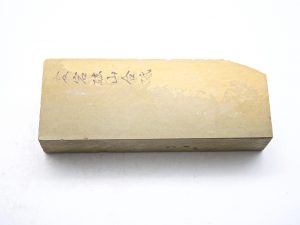
In contrast, the most common natural Japanese whetstones are made from sedimentary rock. The resulting whetstone is softer and wears down faster than your typical Novaculite stones. The upside is that they cut better, meaning they will sharpen knives faster. Japanese whetstones are also only ever used with water, hence they are sometimes referred to as natural Japanese water stones.
There are currently no more operating whetstone mines in Japan. The most famous mining area was just north of Kyoto, but it closed in 1967. As a result, natural Japanese whetstones are difficult to find, and usually very expensive. They are typically only used these days for specialized or ceremonial purposes (i.e. sword sharpening).
Synthetic Whetstones – Oil, Water, Diamond
Most people these days use synthetic / artificial whetstones. They offer better consistency than natural stones, are cheaper / easier to obtain, and they generally cut faster than natural stones. Synthetic stones are made from a bonded abrasive — i.e. abrasive material (usually aluminum oxide or silicon carbide) that is stuck together with a clay/resin/glass binding agent — and shaped into a block. Synthetic whetstones can be further categorized down into oil stones, water stones, and diamond plates.
Synthetic Oil stones
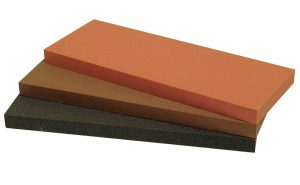
Oil stones are lubricated with oil before the sharpening process. Oil stones are traditionally used more often in Western cultures. Natural Novaculite whetstones (mentioned above) is a type of natural oil stone. Some synthetic stones are made specifically to be used with oil (e.g. India Stones), while others can be used with either oil or water. It is important to note that once you use oil on a stone, you can never use it with water, as it would be ineffective.
Synthetic Water stones
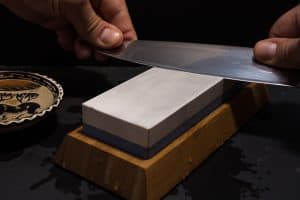
Water stones are lubricated with water before sharpening. This is the traditional process in Japan, where both natural and synthetic stones are only ever used with water. Hence, many people refer to Japanese whetstones as Japanese water stones. These days, many Western brands are also producing synthetic water stones. They are the more popular choice as water is cleaner/easier to use, and also readily available. Water stones sharpen faster, but also wear down faster compared to oil stones. Thus, they tend to require more frequent flattening/maintenance. Just remember to never use oil on your water stone!
Diamond Plates
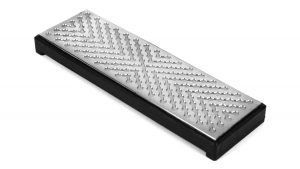
You will also find diamond sharpening plates on the market. They are basically steel plates coated in small diamond bits. Diamond is the hardest mineral on Earth, and thus can be useful for sharpening anything. These plates last an extremely long time, but are also typically more expensive. Diamond plates do not require oil or water. They can be used directly to sharpen knives as well as many other tools. They are more difficult to use, and are generally not recommended for beginners. Diamond plates are also sometimes used to fix (i.e. flatten) water stones which have become uneven after prolonged use.
Whetstone Grit type – Coarse, Medium, and Fine
Whetstones are also categorized by grit. Grit does not just refer to the size of the “grit” particles, but also to the smoothness (or roughness) of the finish produced by the stone. It is similar to sand paper grit, in that a higher number means a smoother finish.
You will find slightly different grit numbers based on the various measuring standards around the world (JIS – Japanese; ANSI – American; FEPA – European). Some individual brands also have their own grit measurement standards. They all tend to be sort of similar, but can result in some confusion when trying to compare products.
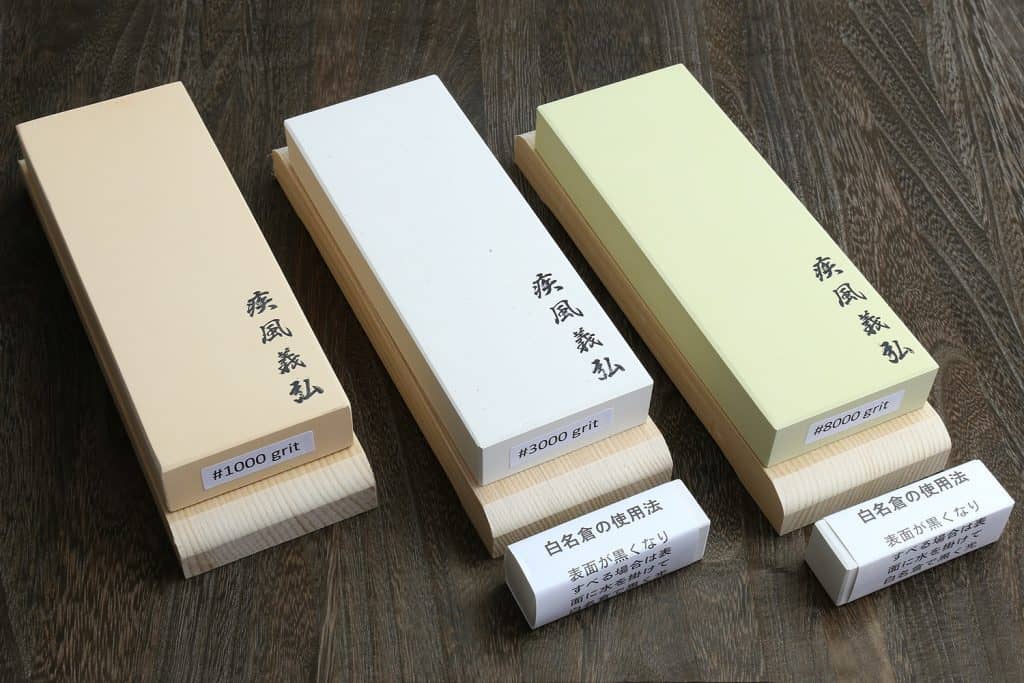
In general though, grit can be divided into three main groups: rough (low grit), medium, and fine (high grit). Some synthetic stones come double sided for convenience (one lower grit side, and one higher grit side). Grit number ranges can differ depending on who you talk to, but here are the breakdowns I’m using.
Rough / Coarse whetstones – Grit range: 200 – 700
Rough whetstones are used to repair damaged or chipped knives. Thus, they are also sometimes referred to as fixing stones. Basically, the bigger the chip or damage you have on your knife, the lower the grit number you want to use. Whetstones on the higher end of this range (i.e. 400-700) probably would not be used for repairing chips, but for sharpening very dull knives.
Medium whetstones – Grit range: 800-2000
Medium grit whetstones are used for general sharpening / maintenance. These are the stones that you will most often be using, especially as a beginner. If you are not sure what to get, it is generally recommended to start with a medium whet stone around 1000 grit. Stones with grit on the higher end of the medium range also blend into the next category: polishing.
Fine / Finishing / Polishing whetstones – Grit range: 3000 – 8000+
Super high grit whetstones are meant for finishing and polishing. They will not make your knife much sharper, but are meant for more for aesthetic purposes (i.e. super shiny knives). After sharpening with a medium whetstone, a finishing stone is often used to remove fine scratches and other imperfections. Finishing stones can get very expensive as the grit level increases. Some stones list their grit up to 30,000! Just remember, a higher grit whetstone does not equate to a sharper knife.
Usage type
As a final note, whetstones can be used to sharpen a variety of knives or cutting tools, not just kitchen knives. Technically, any whetstone can be used to sharpen any tool, although some are designed for specific purposes. For example, some oil stones are more suitable for heavy duty tools like chisels, or wood working tools. Japanese water stones can wear out faster but are more suitable for kitchen knives. You also wouldn’t want to be using kerosene oil in your kitchen.
How to choose a whetstone?
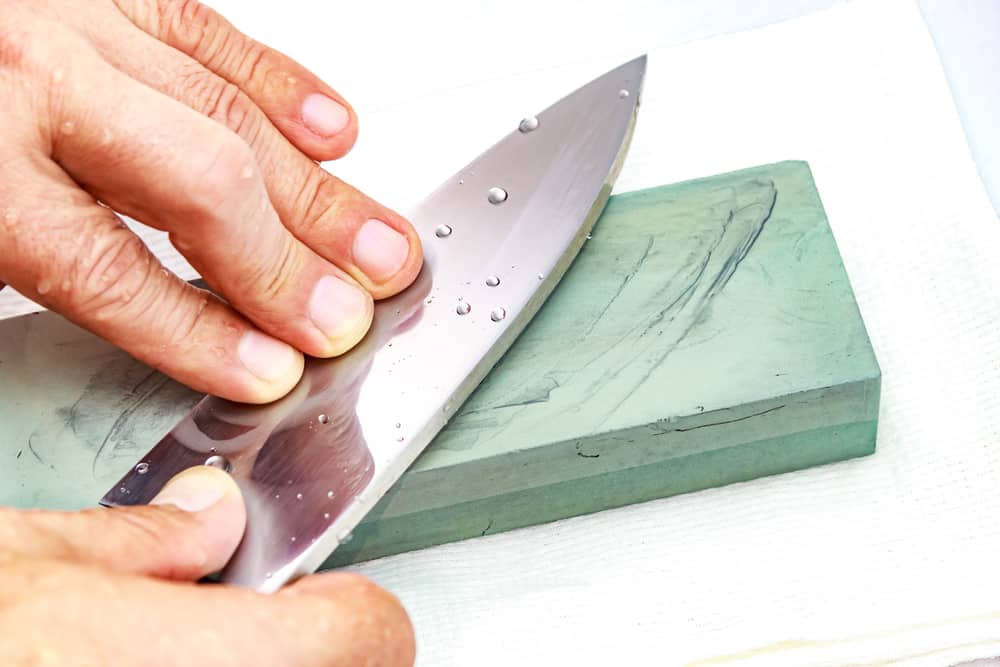
Now, with this plethora of knowledge, how do we choose the best Japanese whetstone? First, understand your own needs and skill level.
Example: I am a home chef, and beginner sharpener that just wants to maintain my Japanese kitchen knives every month or so. I also don’t want to spend a ton of money at first since I want to improve my skills before buying more expensive products.
So, for my purposes, I will look for the following specifications: synthetic, Japanese water stone, medium grit (1k).
Synthetic – A synthetic whetstone is cheaper, easier to find/buy, easier to use, and produces more consistent results. All important things for beginners.
Japanese water stone – I will want a water stone instead of an oil stone. Japanese whetstones/water stones are designed to be used for Japanese kitchen knives. Diamond plates are beyond my level for now, and to flatten my stone I can just buy a cheaper stone fixer/flattener.
I will also look for some trusted Japanese brands that have a history of producing consistent stones. Some of the best whetstone brands from Japan are King, Shapton, Suehiro, Naniwa and Gesshin.
One Medium Grit Whetstone – I just need to maintain my knife every month. It is not damaged or chipped (yet), so I do not need a coarse fixing stone. I do not really care about making it super shiny, so do not need a specialized finishing stone. Therefore, I will target a medium grit whetstone, or possibly consider buying a combo stone (i.e. double sided stone). As I get more knives or improve my sharpening skills, I can look at adding to my collection.
For most home cooks, one medium sharpening stone (around 1000 grit), or double sided combo stone is enough to start. It also saves money :).
Now that you understand your own needs, let’s take a look at some recommendations.
Best Japanese Whetstone Recommendations
Below are some of the best Japanese whetstones you will want to consider depending on your needs / skill level. I have broken it down into three main categories: best beginner; mid-level; and premium.
Remember that sharpening your knife depends much more on your sharpening skill than the specific whetstone or other tools you use. But, a decent stone that matches your abilities will definitely help your sharpening skills improve.
Best beginner whetstone: KING 1000 / 6000
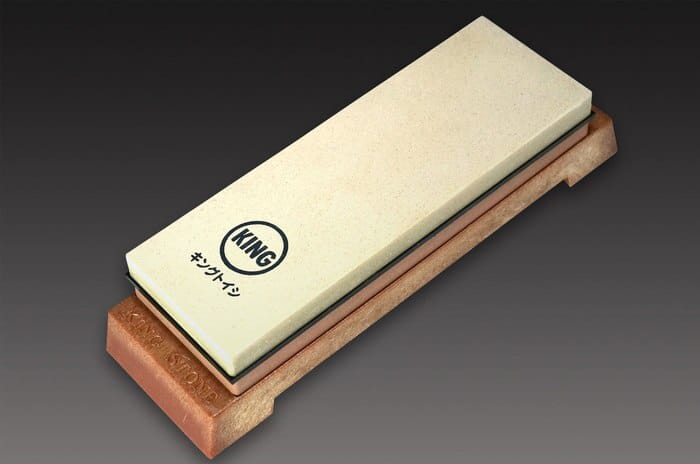
The King 1K/6K combination stone is the most widely recommended Japanese whetstone for beginners.
It is a double sided water stone — the 1000 grit side side for general sharpening / maintenance, and the 6000 grit side for polishing/finishing. This is a great choice for beginners who do not need multiple stones, but still want to practice on a higher grit once in a while.
King (made by Matsunaga Stone Co.) is one of the most well known, and popular whetstone brands from Japan. All of their stones are made in Japan, and are famous for their sharpening consistency, ease-of-use, and low price points. King stones tend to be very soft, which makes them more forgiving to use, but also means they will wear down faster. Despite this, King whetstones are probably the best entry-level, budget friendly Japanese whetstones available.
The King 1K/6K combo stone is extremely well priced at around $40. It usually includes a stand / base as well. It is the perfect entry level choice for beginners looking to practice their sharpening skills.
Buy the King 1K/6K on Amazon
Also available at: Hocho Knife
Other good beginner options: Suehiro 1k/3k (sometimes called Cerax brand)
Best mid-level whetstone: Shapton Pro / Ha No Kuromaku 1000
If you want a step up from entry-level choices, then the most recommended mid-level brand is Shapton. For regular maintenance and sharpening (i.e. medium grit stone), the Shapton Pro 1000 (officially called Ha No Kuromaku 1000) is an excellent choice.
Shapton whetstones are harder than King or Suehiro, and thus will stay flat longer. Complete beginners may find it a bit more difficult to use a harder stone, as it will give less feedback when sharpening. Despite this, the Shapton 1k sharpens very quickly, and is highly regarded among all levels of knife sharpeners worldwide. Another interesting, and convenient aspect of the Shapton Pro stones is that they do not need to be soaked in water before using. They simply need to be splashed. Thus, these stones are sometimes known as “splash and go” stones.
The Shapton Pro / Kuromaku 1000 is a great overall sharpening stone for pros and amateurs alike. If you are a beginner looking to take a step up in your sharpening game, then it is an excellent choice. The Shapton Ha No Kuromaku whetstone line is available in many grit sizes in case you need a coarse/fixing stone or fine/polishing stone. They are also very affordable, with the Shapton 1k price around $45.
Buy the Shapton 1000 at Hocho Knife or Amazon
Check out the full line of Shapton/Kuromaku whetstones here
Other good mid-level options: Naniwa Super 1k, Imanishi 1k/6k combo
Best Premium Whetstones: Gesshin Brand
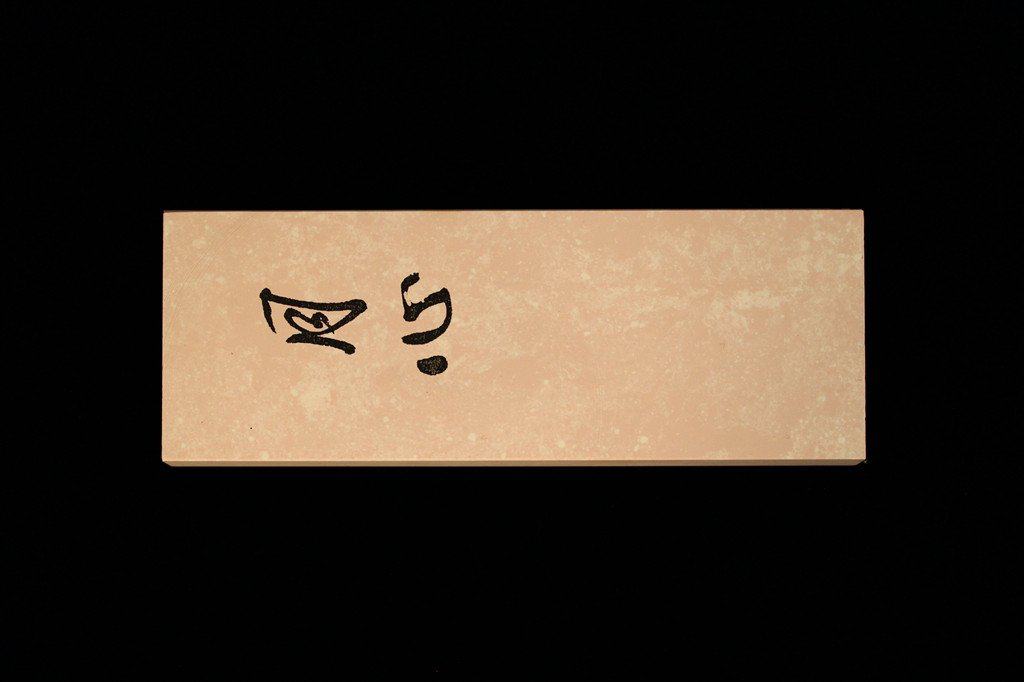
If you are already a highly skilled sharpener, and want a top-of-the-line product to take care of your knives, then you should consider the premium whetstones from Gesshin.
Gesshin stones are renowned by sharpening enthusiasts for their ability to cut/sharpen insanely fast, and the excellent tactical feedback they give when sharpening. They are suitable to be used with high-end, honyaki forged carbon steel blades, as well as lower end stainless steel. The medium grit stones (1k-2k) leave excellent finishes compared to other brands, which means you do not really need a finer grit polishing stone if you’re lazy. Gesshin stones also resist “dishing” well, which basically means they will stay flat for a longer time compared to softer stones like King.
The only downside of Gesshin sharpening stones is that they are expensive — usually around $100+ per stone. This is double or triple the cost of an entry level King or Shapton whetstone. If you are an experienced sharpener looking for a premium whetstone to take care of your Japanese kitchen knives, then this may not be an issue.
Gesshin whetstones are available in all varieties of grit ranges as well as combo stones, so you are sure to find one that matches your needs.
They are available for purchase from Japanese Knife Imports.
Other premium whetstones to consider: Naniwa Professional Line / Chosera / Naniwa Pro 800 on Amazon / Naniwa Pro 3000 on Amazon
Conclusion
In this guide, we learned what a whetstone is; reviewed the different types / categories of whetstones; and looked at some different things to consider when buying.
We then looked at a few recommendations of the best Japanese whetstones depending on your skills and needs.
Just remember that sharpening depends much more on your technique/skill than the exact whetstone you use. A decent whetstone will definitely help you practice/improve your skills, but try not to get caught up in choosing the “perfect” stone. This is especially true if you are just starting out.
I hope this guide was helpful. What type of sharpening stone do you use? Let me know in the comments below!
What to read next
Once you have chosen your Japanese whetstone, remember to read the knife sharpening and maintenance guide.
Which steel is easier to sharpen? Get a better understanding of Japanese knife steel.
Looking for a new knife? Check out the best Japanese knives guide.
Sources
https://ja.wikipedia.org/wiki/%E7%A0%A5%E7%9F%B3
https://en.wikipedia.org/wiki/Sharpening_stone#Japanese_waterstones
https://www.fine-tools.com/japwas.html
https://www.reddit.com/r/chefknives/wiki/whetstones
https://knife-japan.hatenablog.com
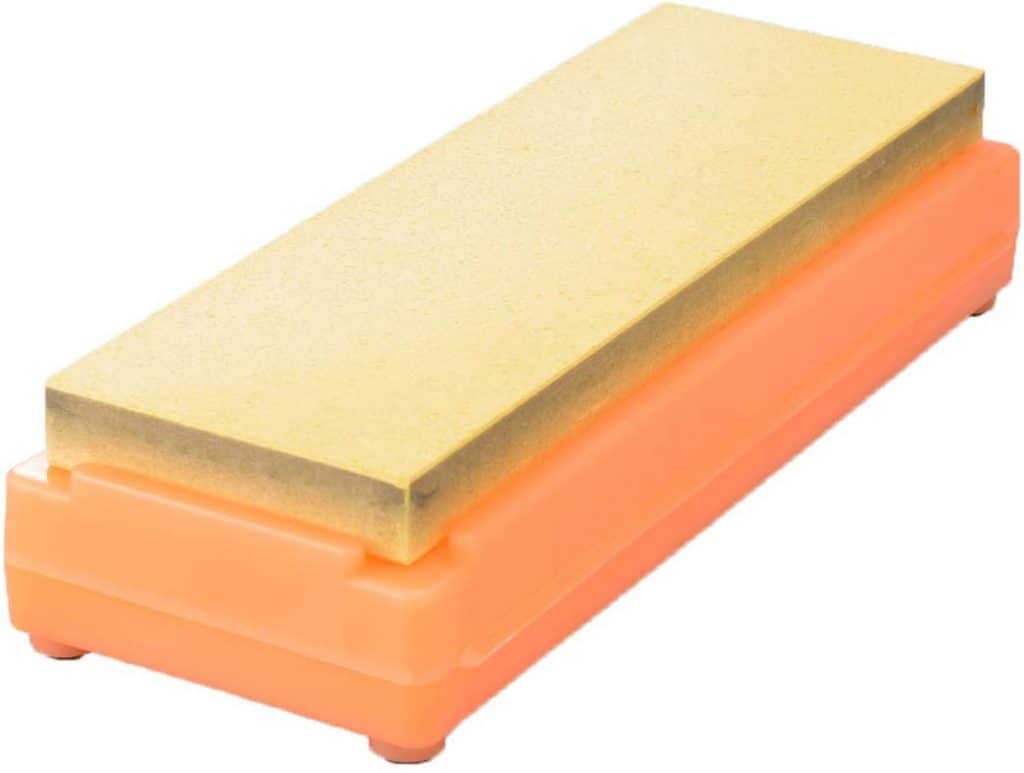
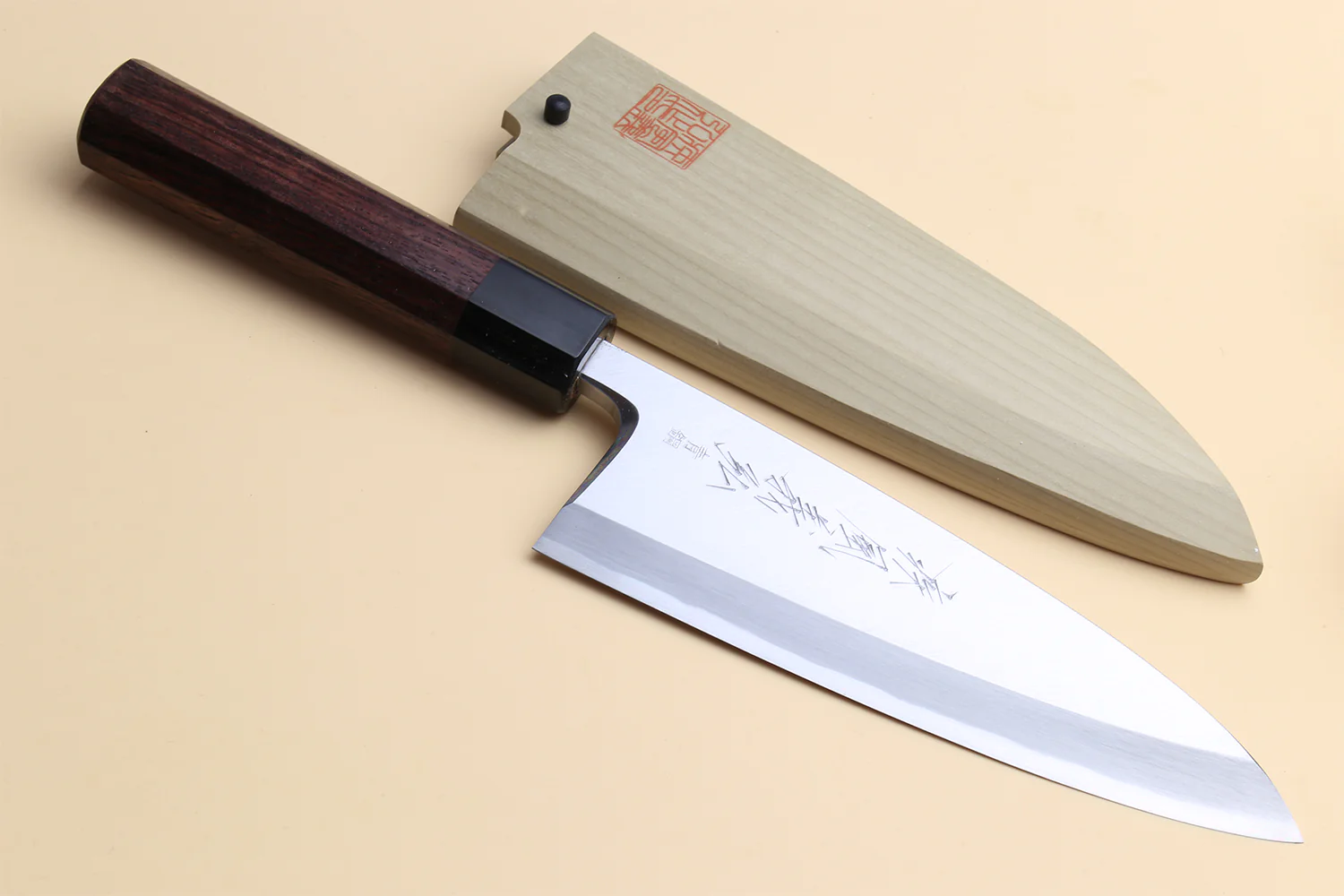
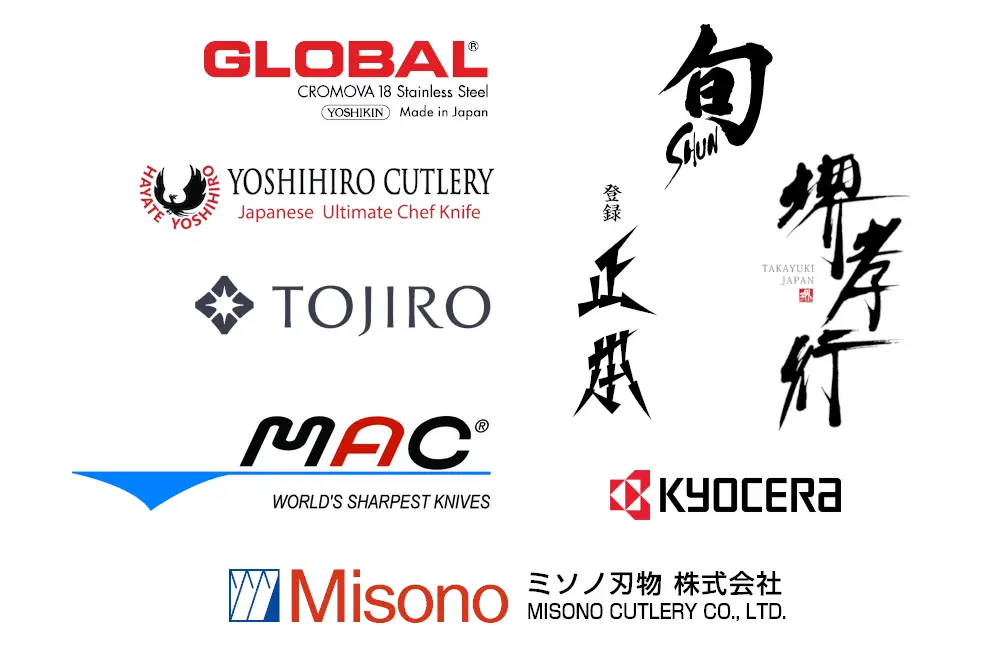
Thank you for your article, this is what I needed.
I have Wusthof knives (3 1/2 & 6″ Chef’s knives). I am wanting to learn to sharpen them myself and I think the King whetstone is the best one for me. I would appreciate any advice on this matter.
Sincerely,
EM
Thank you for teaching me about whet stones. Good Life to you.
My son has a Japanese knife. He is new to whetstones am I better to buy him the Shapton 1000, king 1000/6000 or Naniwa Pro? I was going to buy him the Shapton but after reading your article wonderd if the King is a better option until he becomes more proficient